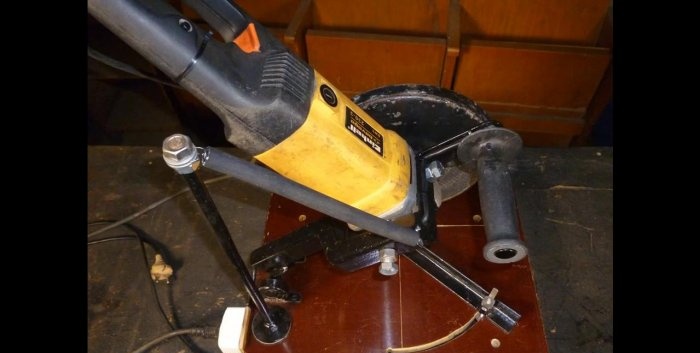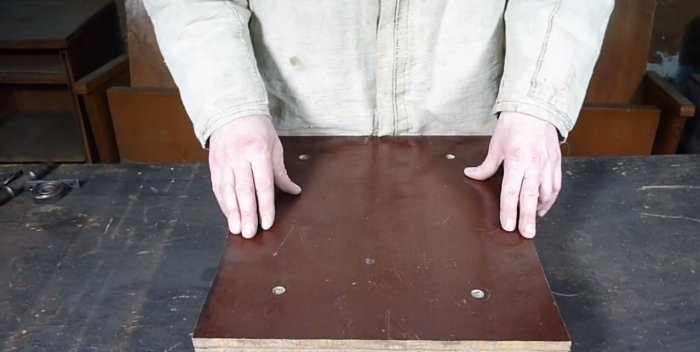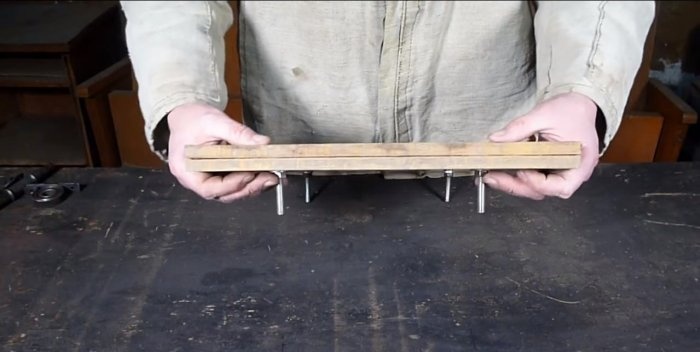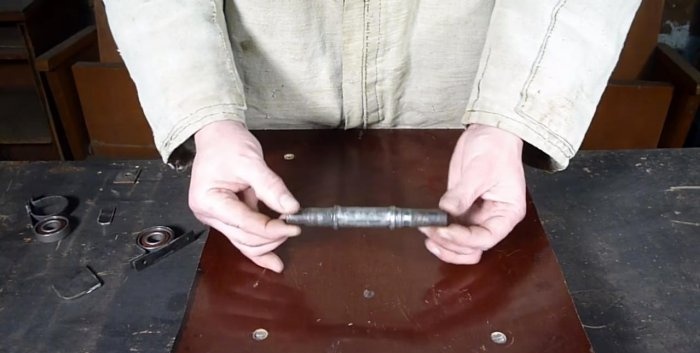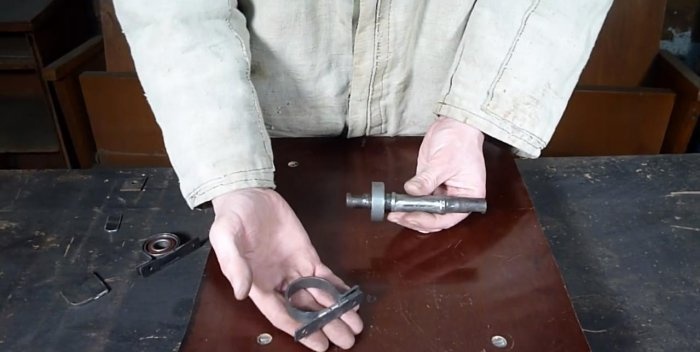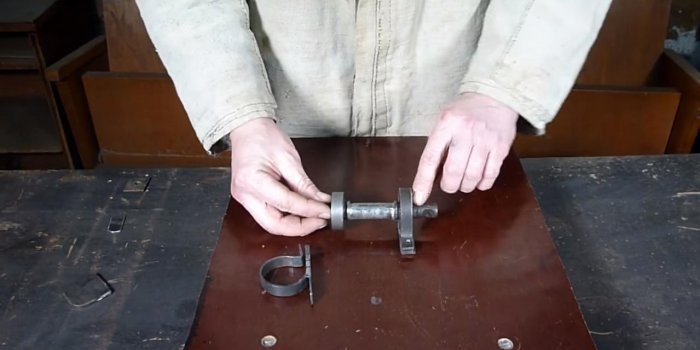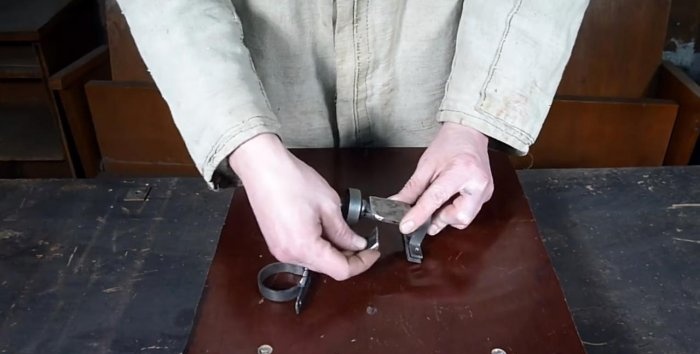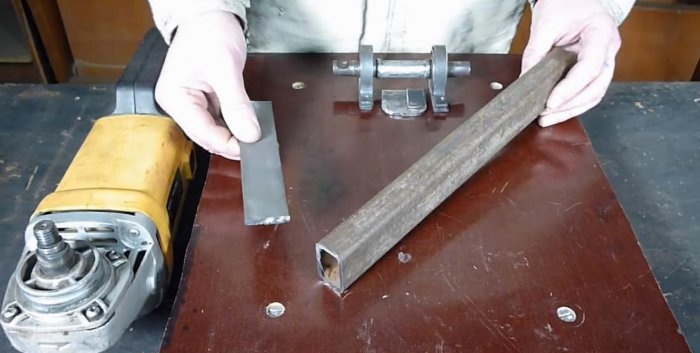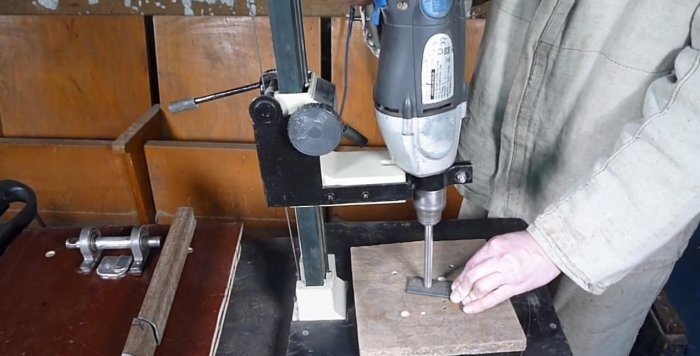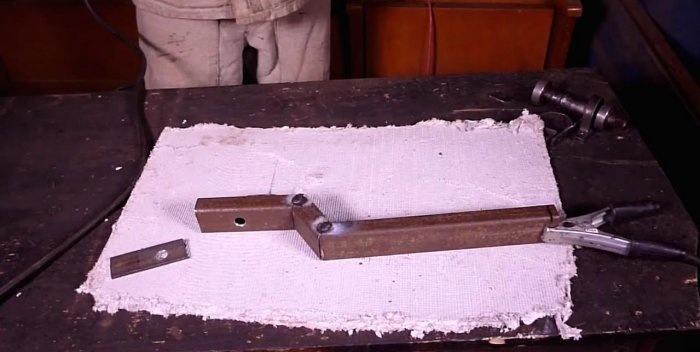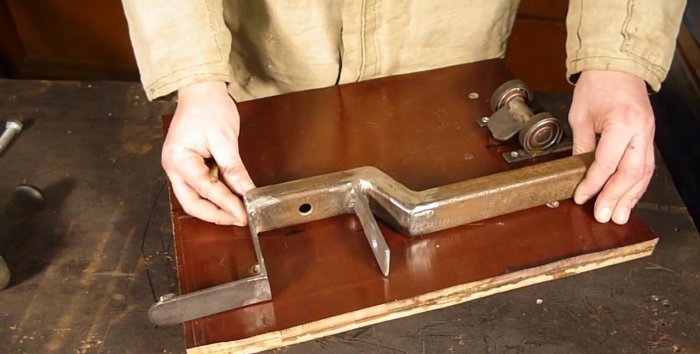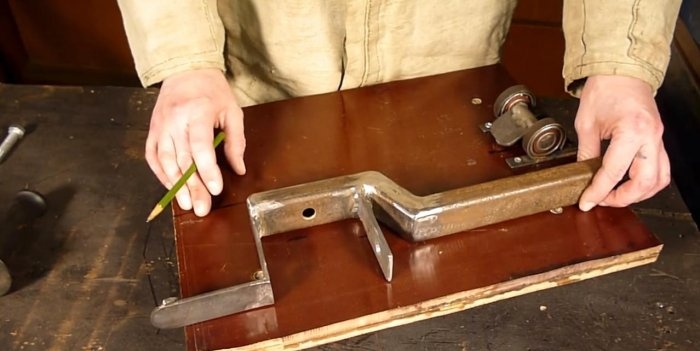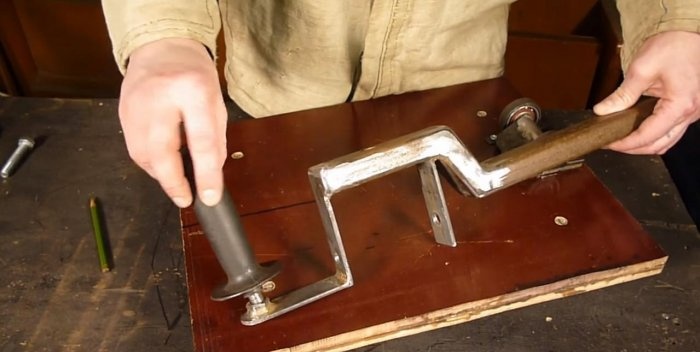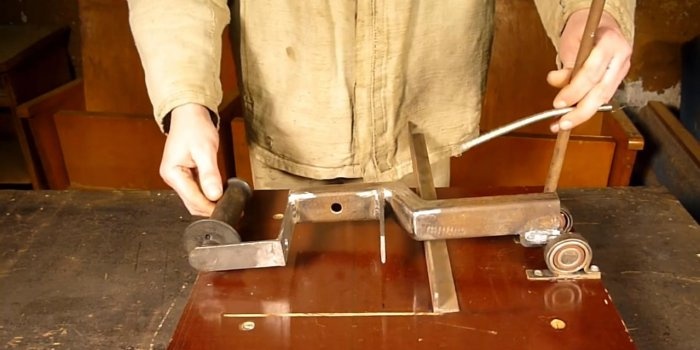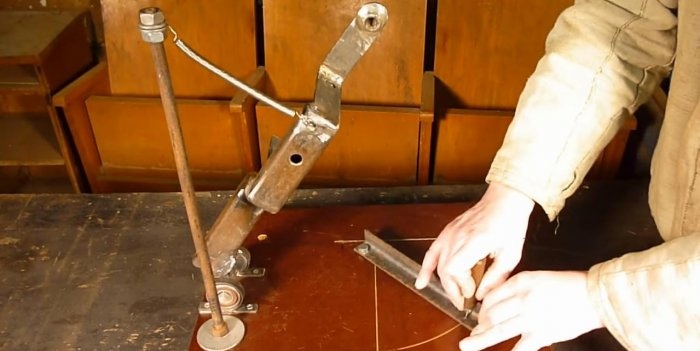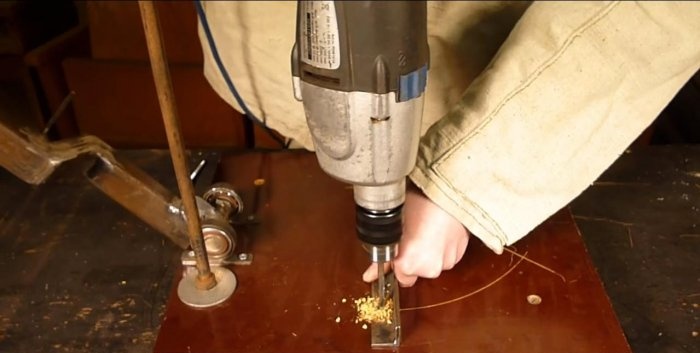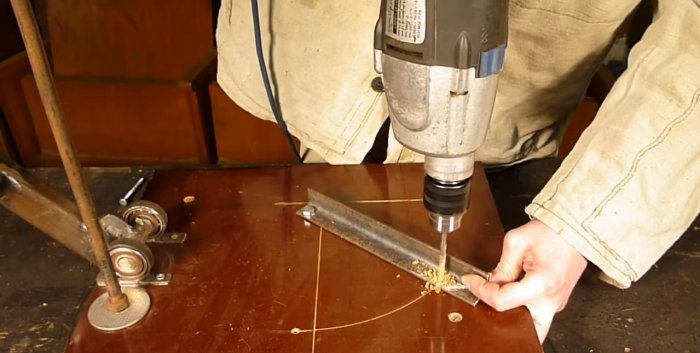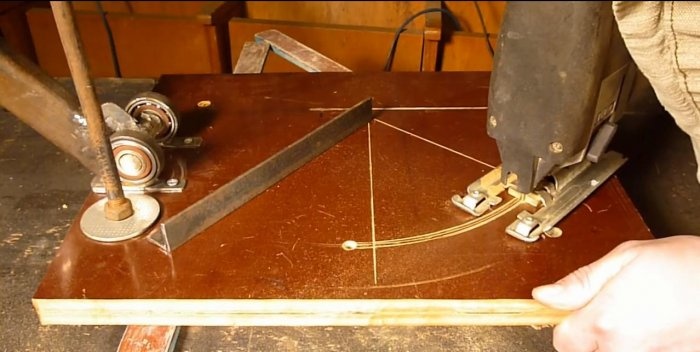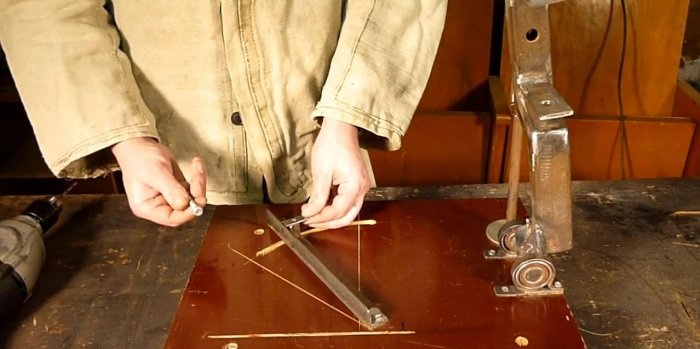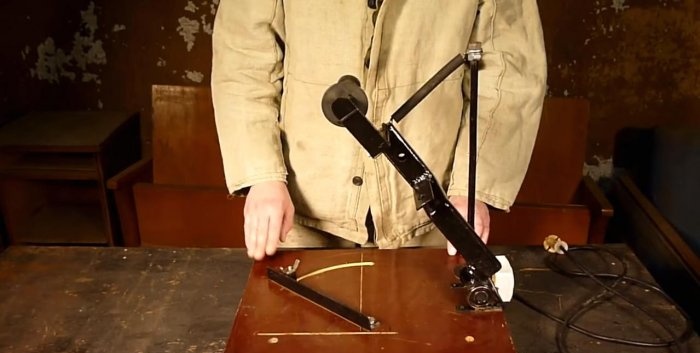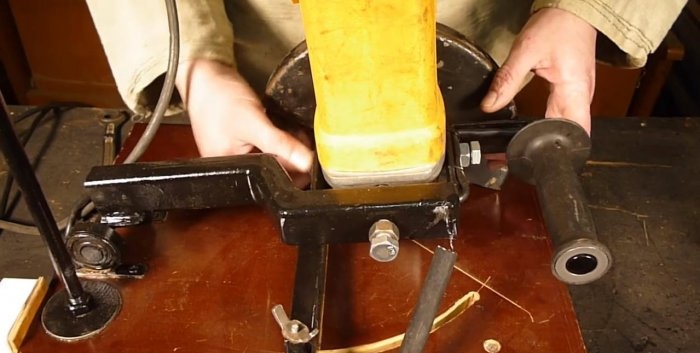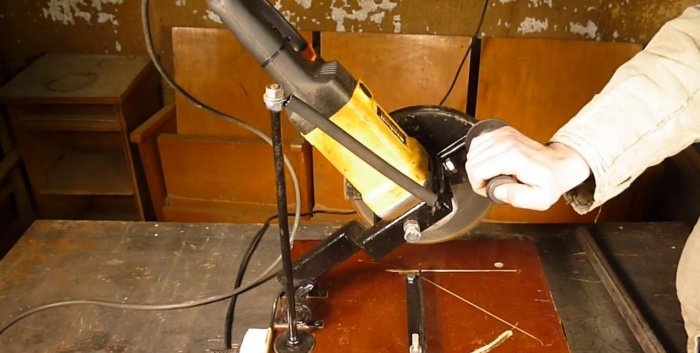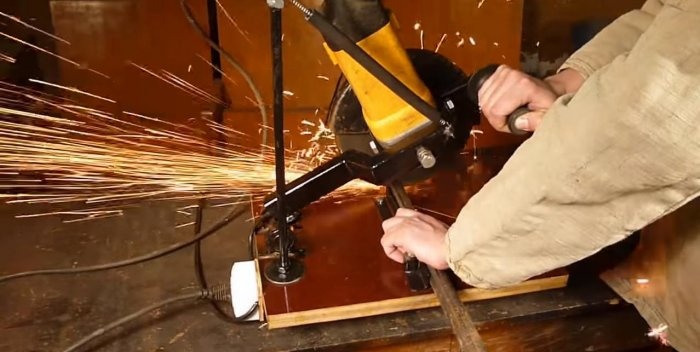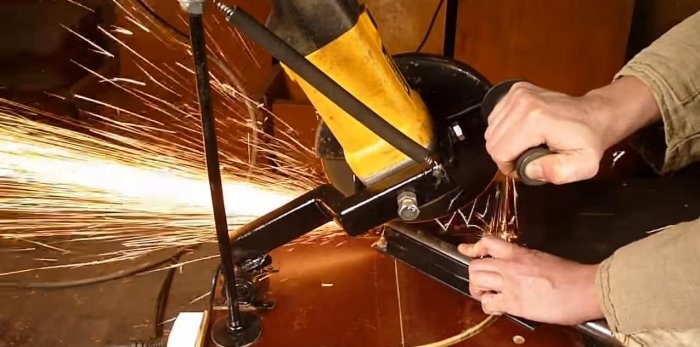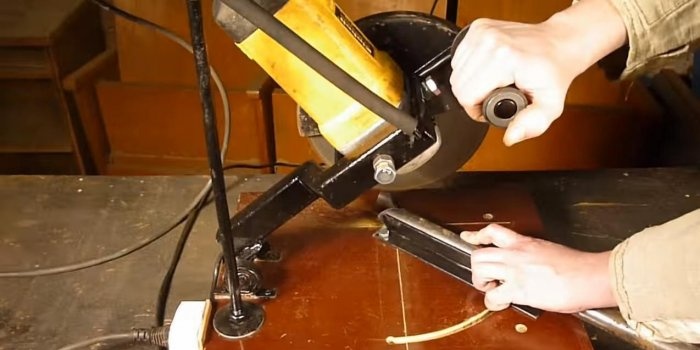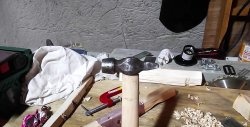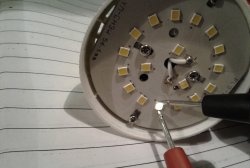Stand for an angle grinder or pendulum saw from an angle grinder
A miter box or electric miter box is often used by craftsmen to speed up the process of cutting various parts. It was chosen not only by large productions, but also by private workshops. After all, they can easily and quickly saw off almost any common material - wood, plastic, metal, etc.
Professional pendulum saws are very precise tools, because that's the beauty of them. A regular cut can be done with anything, for example, a grinder, a jigsaw or a hacksaw. The trim saw cuts strictly at a given angle, which is very important in the manufacture of metal structures, furniture or plastic windows.
Such a professional tool is quite expensive. We offer a homemade trimming option based on a grinder. It has enough revolutions, and the width of the disk will allow you to cut more than one workpiece, which will make this device quite in demand for any workshop.
Materials:
Tools:
The author chose an excellent material for the frame – textolite. It does not burn, does not deform under the influence of temperature and is absolutely moisture resistant. Two sheets of textolite are spliced together using epoxy resin and secured with bolts at the corners, which in addition also serve as legs for the machine.
An axle from a bicycle carriage is suitable for the movable shaft of the lever. This part has projections that are used to fit bearings. To secure the bearings to the frame you will need two clamps. They can be made from any metal strip of suitable width.
We secure the movable shaft with bearings to the bolts to the frame with clamps. The middle of the shaft axis must be prepared (cleaned) for a welded connection with the adapter plate to the lever. Subsequently, it will be reinforced with a stiffening rib made from a small piece of metal.
The lever mechanism is made from a profile pipe.This molding is convenient because it has strict edges and a regular cross-sectional shape, which means it will not be difficult to maintain an even tilt path of the angle grinder.
The curved part is equal to the size of the grinder's gear head. We cut it with a grinder and weld the corner joints. It is also necessary to make holes for attaching the tool. Since it weighs a lot, holes for the mounting bolts must be on all three planes with which the angle grinder is adjacent to the lever.
The final element will be a plate placed at right angles to the tilt axis of the lever. The handle of our cross-cutting tool will be secured in it.
We weld an adapter plate to the end of the lever and also secure it to the shaft. At the opposite end of the lever we mount the handle.
The return mechanism of the lever on the pendulum saw is performed by various spring mechanisms. In our case, this will be a very simple option, consisting of a rod and a spring stretched over a lever. We cut a thread about 5-6 cm deep into the end of the metal rod. Screw the nut until it stops, attach it with a washer and pull the stand on the frame almost close to the bearings so as not to weaken the spring. We clamp one end of the spring with two nuts on the rod, and hook the other to the welded nut on the lever.
To more securely place the workpieces on the frame, it is necessary to make a stop bar. We make it from a small metal corner 30x30 mm. We fasten it to one bolt at the very edge of the cut left by the grinder to mark the boundary of its work on the frame. This fastening will allow you to change the angle of facing relative to the workpiece resting on this bar.
To fix the second edge of the stop, you also need to make a hole for the bolted connection.Using the hole, we mark the trajectory of the bar's movement along an arc. We drill a hole for the jigsaw file and make a groove with a jigsaw that is as wide as the free play of the clamping bolt.
It will be more convenient to press the stop if you weld a small piece of 15x15 square pipe with an arbitrary washer at the top in place of the hole. The bolt can be taken longer so that the wing nut can be tightened easily and quickly by hand.
The metal elements of the machine must be cleaned with a grinder or sandpaper, primed, and then painted. This way the metal will be preserved better and longer, and will be reliably protected from corrosion.
According to the scheme proposed by the author, we mount the grinder's power button in the lever handle. On such angle grinders, the standard power button does not lock. Here we can place it at will. The instrument connection cable can be left as standard. We will connect it to the socket, which is fixed in the end part of the frame. It is advisable to choose a waterproof one for outdoor use, which will protect the connection and make it more durable and reliable.
Our homemade pendulum saw is ready. Now you can clamp the angle grinder in it and use the extension cord to test it in action.
This is how, using scrap materials, you can make a simple and practical tool that is convenient to use, for example, when working on objects.
Professional pendulum saws are very precise tools, because that's the beauty of them. A regular cut can be done with anything, for example, a grinder, a jigsaw or a hacksaw. The trim saw cuts strictly at a given angle, which is very important in the manufacture of metal structures, furniture or plastic windows.
Such a professional tool is quite expensive. We offer a homemade trimming option based on a grinder. It has enough revolutions, and the width of the disk will allow you to cut more than one workpiece, which will make this device quite in demand for any workshop.
Advantages of a pendulum saw
- Cutting accuracy;
- Possibility to cut the workpiece at any angle;
- Work safety;
- Versatility - you can cut wood, plastic, metal;
- Speed;
- Practicality (convenience) of work.
Resources needed to make a homemade trim cutter
Materials:
- Textolite, thickness – 1 cm;
- Axle from a bicycle carriage;
- Grinder with a 230 mm disc;
- Section of profile pipe 40x25;
- Metal plates 30-40 mm wide, 3-4 mm thick;
- Pair of ball bearings with clamps;
- Metal rod with a diameter of 10-12 mm;
- Elastic spring;
- Metal corner 30x30 mm;
- Metal paint;
- Bolts, nuts, washers.
Tools:
- Bulgarian;
- Jigsaw;
- Drill or benchtop drilling machine;
- Epoxy adhesive;
- Welding machine;
- Wrenches, pliers;
- Tape measure, pencil.
Manufacturing process
Bed and movable shaft
The author chose an excellent material for the frame – textolite. It does not burn, does not deform under the influence of temperature and is absolutely moisture resistant. Two sheets of textolite are spliced together using epoxy resin and secured with bolts at the corners, which in addition also serve as legs for the machine.
An axle from a bicycle carriage is suitable for the movable shaft of the lever. This part has projections that are used to fit bearings. To secure the bearings to the frame you will need two clamps. They can be made from any metal strip of suitable width.
We secure the movable shaft with bearings to the bolts to the frame with clamps. The middle of the shaft axis must be prepared (cleaned) for a welded connection with the adapter plate to the lever. Subsequently, it will be reinforced with a stiffening rib made from a small piece of metal.
We make a lever for trimming
The lever mechanism is made from a profile pipe.This molding is convenient because it has strict edges and a regular cross-sectional shape, which means it will not be difficult to maintain an even tilt path of the angle grinder.
The curved part is equal to the size of the grinder's gear head. We cut it with a grinder and weld the corner joints. It is also necessary to make holes for attaching the tool. Since it weighs a lot, holes for the mounting bolts must be on all three planes with which the angle grinder is adjacent to the lever.
The final element will be a plate placed at right angles to the tilt axis of the lever. The handle of our cross-cutting tool will be secured in it.
We weld an adapter plate to the end of the lever and also secure it to the shaft. At the opposite end of the lever we mount the handle.
Return stand, thrust bar
The return mechanism of the lever on the pendulum saw is performed by various spring mechanisms. In our case, this will be a very simple option, consisting of a rod and a spring stretched over a lever. We cut a thread about 5-6 cm deep into the end of the metal rod. Screw the nut until it stops, attach it with a washer and pull the stand on the frame almost close to the bearings so as not to weaken the spring. We clamp one end of the spring with two nuts on the rod, and hook the other to the welded nut on the lever.
To more securely place the workpieces on the frame, it is necessary to make a stop bar. We make it from a small metal corner 30x30 mm. We fasten it to one bolt at the very edge of the cut left by the grinder to mark the boundary of its work on the frame. This fastening will allow you to change the angle of facing relative to the workpiece resting on this bar.
To fix the second edge of the stop, you also need to make a hole for the bolted connection.Using the hole, we mark the trajectory of the bar's movement along an arc. We drill a hole for the jigsaw file and make a groove with a jigsaw that is as wide as the free play of the clamping bolt.
It will be more convenient to press the stop if you weld a small piece of 15x15 square pipe with an arbitrary washer at the top in place of the hole. The bolt can be taken longer so that the wing nut can be tightened easily and quickly by hand.
The metal elements of the machine must be cleaned with a grinder or sandpaper, primed, and then painted. This way the metal will be preserved better and longer, and will be reliably protected from corrosion.
Electrics
According to the scheme proposed by the author, we mount the grinder's power button in the lever handle. On such angle grinders, the standard power button does not lock. Here we can place it at will. The instrument connection cable can be left as standard. We will connect it to the socket, which is fixed in the end part of the frame. It is advisable to choose a waterproof one for outdoor use, which will protect the connection and make it more durable and reliable.
Our homemade pendulum saw is ready. Now you can clamp the angle grinder in it and use the extension cord to test it in action.
This is how, using scrap materials, you can make a simple and practical tool that is convenient to use, for example, when working on objects.
Safety precautions when working with a homemade pendulum saw
- Do not forget about safety precautions when working with such a tool. Protective gloves and glasses must be worn;
- The grinder must be positioned so that the burning abrasive from the discs flies away from the machine and not towards the operator;
- The angle grinder casing must be securely fastened and turned towards the operator to protect him;
- Do not put excessive pressure on the disc when sawing. Play in such a homemade device is inevitable, which means the disk can jam or even break during operation.
Watch video instructions
Similar master classes
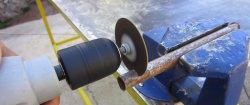
Cutting attachment for a drill from a grinder disc
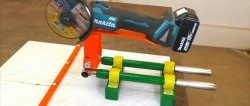
A stand for an angle grinder made from the handle of a children's bicycle. Extremely
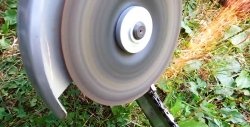
Quickly sharpening a chainsaw chain with a grinder
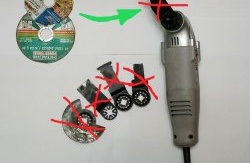
Do-it-yourself universal nozzle for renovator (MFI)

A simple stand for an angle grinder made from a bicycle
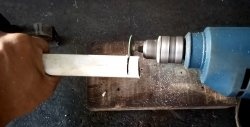
Cutting attachment for screwdriver
Particularly interesting
Comments (2)

